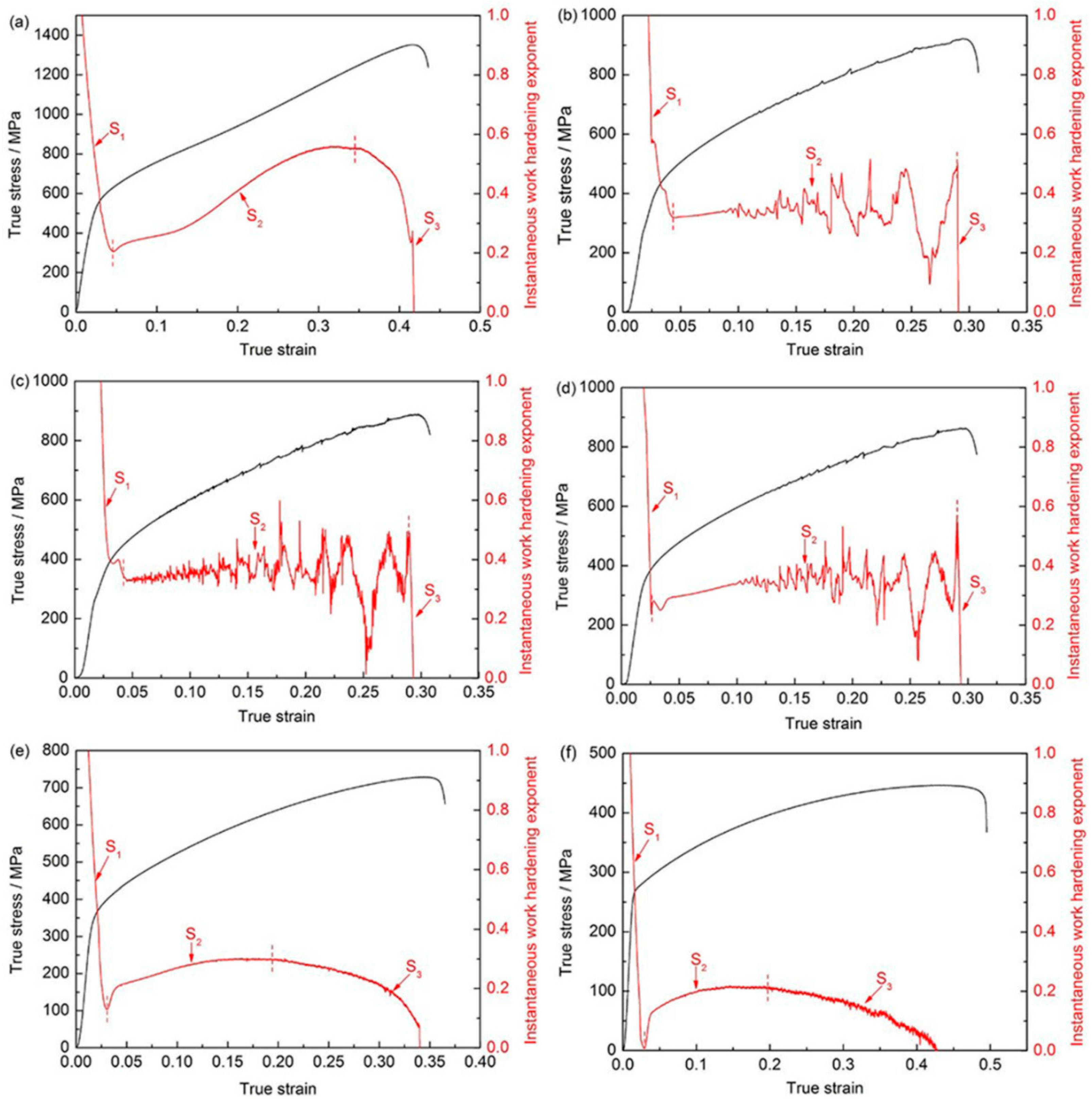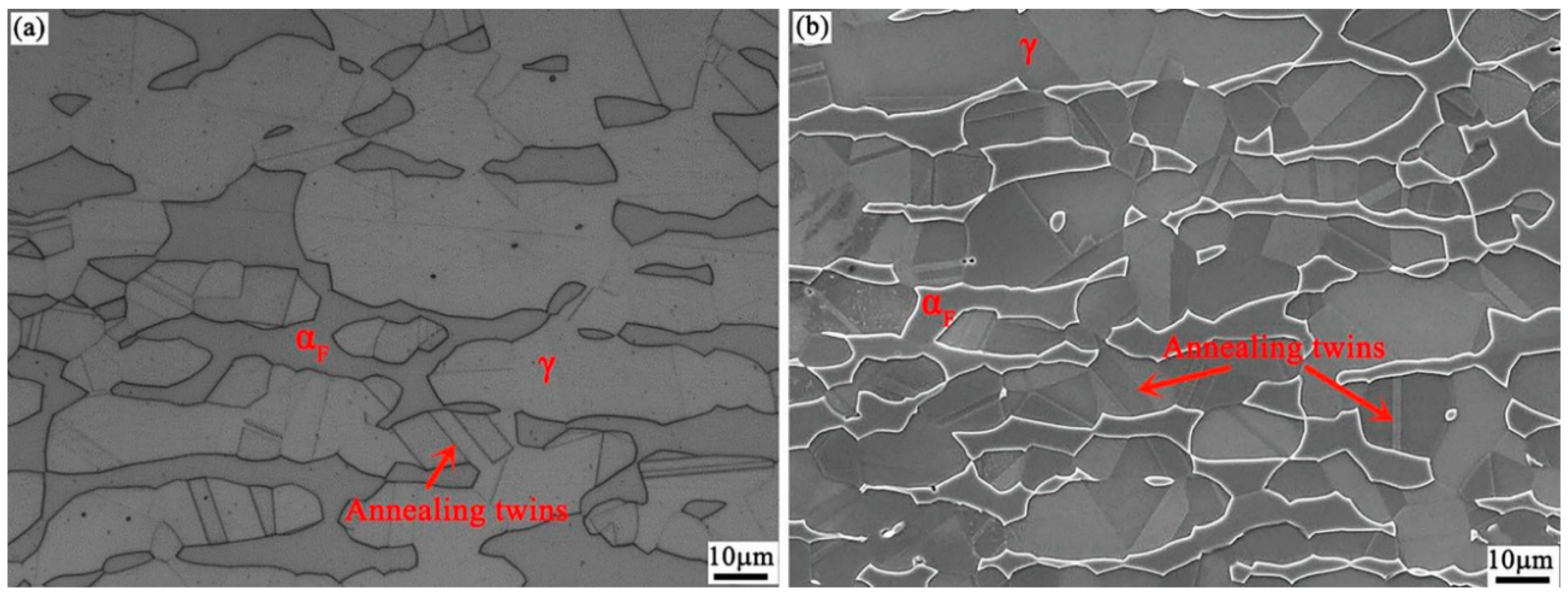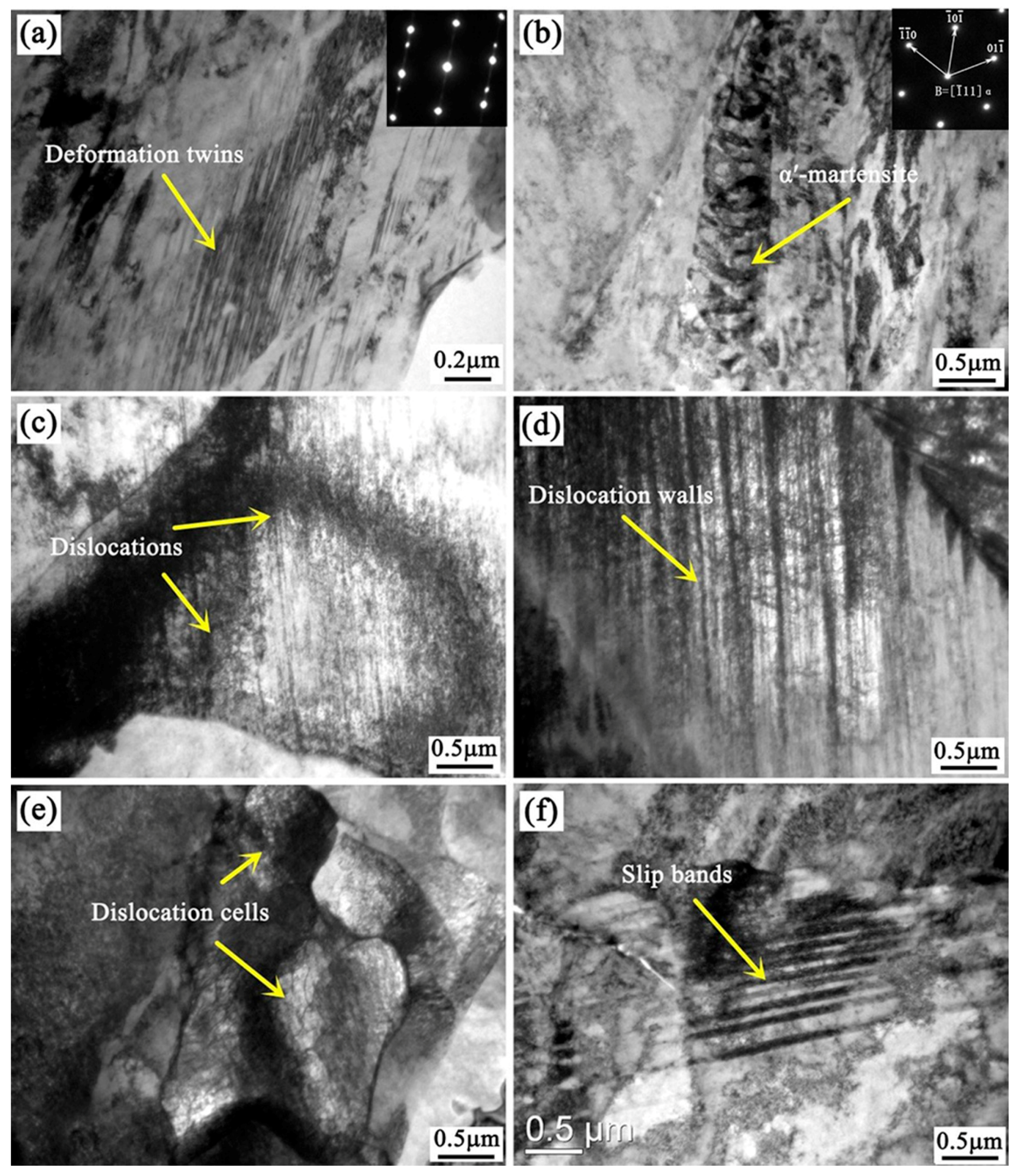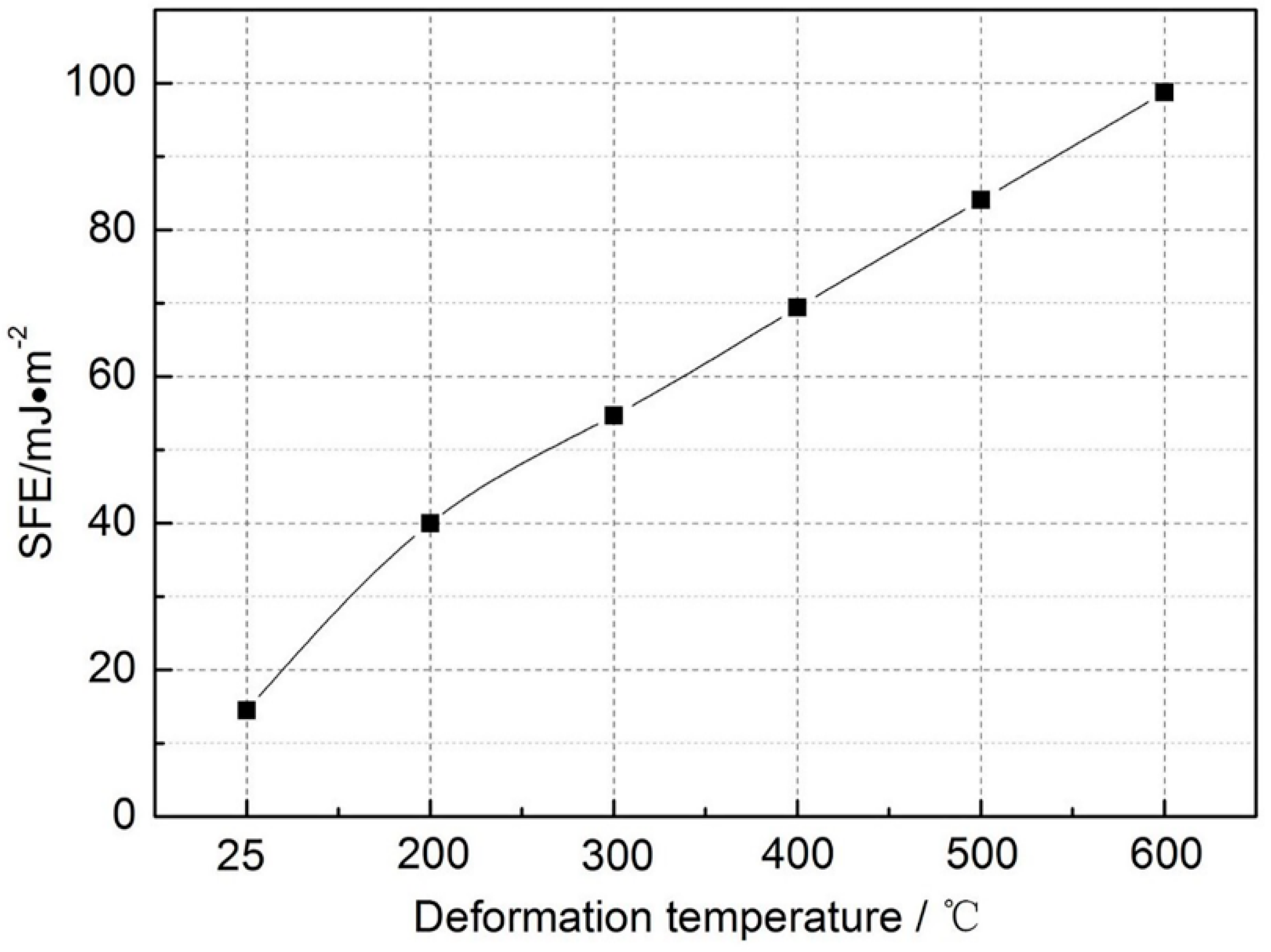Effect of Deformation Temperature on Mechanical Properties and Deformation Mechanisms of Cold-Rolled Low C High Mn TRIP/TWIP Steel
Abstract
1. Introduction
2. Materials and Methods
3. Results
3.1. Mechanical Properties and Work Hardening Behavior
3.2. Microstructure
4. Discussion
4.1. Effect of Deformation Temperature on the Deformation Mechanism
4.2. Tensile Properties Difference at Different Temperatures
5. Conclusions
- Fe-18.1Mn-3.1Al-3.2Si-0.03C TRIP/TWIP steel exhibited excellent mechanical properties at room temperature. The UTS, TEL and PSE were 905 MPa, 55% and 49.3 GPa, respectively. The dominant plasticity mechanism at room temperature was strain induced martensite deformation and deformation twinning.
- With the increase of deformation temperature from 25 (room temperature) to 600 °C, the SFE of the experimental steel was in the range of 14.5 to 98.8 mJm−2. The deformation mechanism of the experimental steel is controlled by both the strain induced martensite formation and strain induced deformation twinning at 25 °C. With the increase of deformation temperature from 25 to 600 °C, TRIP and TWIP effects were inhibited, and dislocation glide gradually became the main deformation mechanism.
- The UTS decreased monotonously from 905 to 325 MPa and the TEL decreased (from 55 to 36%, 25–400 °C) and then increased (from 36 to 64%, 400–600 °C). The change in mechanical properties was related to the thermal softening effect, TRIP effect, TWIP effect, DSA, and dislocation slip.
Author Contributions
Funding
Acknowledgments
Conflicts of Interest
References
- Ding, H.; Tang, Z.Y.; Li, W.; Wang, M.; Song, D. Microstructures and mechanical properties of Fe-Mn-(Al, Si) TRIP/TWIP steels. J. Iron Steel Res. 2006, 13, 66–70. [Google Scholar] [CrossRef]
- Ding, H.; Ding, H.; Song, D.; Tang, Z.Y.; Yang, P. Strain hardening behavior of a TRIP/TWIP steel with 18.8% Mn. Mater. Sci. Eng. A 2011, 528, 868–873. [Google Scholar] [CrossRef]
- Shterner, V.; Timokhina, I.B.; Beladi, H. On the work-hardening behaviour of a high manganese TWIP steel at different deformation temperatures. Mater. Sci. Eng. A 2016, 669, 437–446. [Google Scholar] [CrossRef]
- Tang, Z.Y.; Misra, R.D.K.; Ma, M.; Zan, N.; Wu, Z.Q.; Ding, H. Deformation twinning and martensitic transformation and dynamic mechanical properties in Fe-0.07C-23Mn-3.1Si-2.8Al TRIP/TWIP steel. Mater. Sci. Eng. A 2015, 624, 186–192. [Google Scholar] [CrossRef]
- Dufay, A.; Chateau, J.P.; Allain, S.; Migot, S.; Bouaziz, O. Influence of addition elements on the stacking-fault energy and mechanical properties of an austenitic Fe-Mn-C steel. Mater. Sci. Eng. A 2008, 483–484, 184–187. [Google Scholar]
- Allain, S.; Chaterau, J.P.; Bouaziz, O.; Migot, S.; Guelton, N. Correlations between the calculated stacking fault energy and the plasticity mechanisms in Fe-Mn-C alloys. Mater. Sci. Eng. A 2004, 387–389, 158–162. [Google Scholar] [CrossRef]
- Linderov, M.; Segel, C.; Weidner, A.; Biermann, H.; Vinogradov, A. Deformation mechanisms in austenitic TRIP/TWIP steels at room and elevated temperature investigated by acoustic emission and scanning electron microscopy. Mater. Sci. Eng. A 2014, 597, 183–193. [Google Scholar] [CrossRef]
- Pierce, D.T.; Jiménez, J.A.; Bentley, J.; Raabe, D.; Witting, J.E. The influence of stacking fault energy on the microstructural and strain-hardening evolution of Fe-Mn-Al-Si steels during tensile deformation. Acta Mater. 2015, 100, 178–190. [Google Scholar] [CrossRef]
- Kim, J.K.; Chen, L.; Kim, H.S.; Kim, S.K.; Estrin, Y.; De Cooman, B.C. On the tensile behavior of high-manganese twinning-induced plasticity steel. Metall. Mater. Trans. A 2009, 40, 3147–3158. [Google Scholar] [CrossRef]
- Chen, L.; Kim, H.S.; Kim, S.K.; De Cooman, B.C. Localized deformation due to Portevin-LeChatelier effect in 18Mn-0.6C TWIP austenitic steel. ISIJ Int. 2007, 47, 1804–1812. [Google Scholar] [CrossRef]
- Lee, S.J.; Kim, J.Y.; Kane, S.N.; De Cooman, B.C. On the origin of dynamic strain aging in twinning-induced plasticity steels. Acta Mater. 2011, 59, 6809–6819. [Google Scholar] [CrossRef]
- Kim, J.G.; Hong, S.; Anjabin, N.; Park, B.H.; Kim, S.K.; Chin, K.G.; Lee, S.; Kim, H.S. Dynamic strain aging of twinning-induced plasticity (TWIP) steel in tensile testing and deep drawing. Mater. Sci. Eng. A 2015, 633, 136–143. [Google Scholar] [CrossRef]
- Taheri, A.K.; Maccagno, T.M.; Jonas, J.J. Dynamic strain aging and the wire drawing of low carbon steel rods. ISIJ Int. 1995, 35, 1532–1540. [Google Scholar] [CrossRef]
- Li, C.C.; Leslie, W.C. Effects of dynamic strain aging on the subsequent mechanical properties of carbon steels. Metall. Trans. A 1978, 9, 1765–1775. [Google Scholar] [CrossRef]
- Shahriary, M.S.; Koohbor, B.; Ahadi, K.; Ekrami, A.; Khakian-Qomi, M.; Izadyar, T. The effect of dynamic strain aging on room temperature mechanical properties of high martensite dual phase (HMDP) steel. Mater. Sci. Eng. A 2012, 550, 325–332. [Google Scholar] [CrossRef]
- Bayramin, B.; Şimşir, C.; Efe, M. Dynamic strain aging in DP steels at forming relevant strain rates and temperatures. Mater. Sci. Eng. A 2017, 704, 164–172. [Google Scholar] [CrossRef]
- Jung, I.C.; De Cooman, B.C. Temperature dependence of the flow stress of Fe-18Mn-0.6C-xAl twinning-induced plasticity steel. Acta Mater. 2013, 61, 6724–6735. [Google Scholar] [CrossRef]
- Benzing, J.T.; Poling, W.A.; Pierce, D.T.; Witting, J.E. Effects of strain rate on mechanical properties and deformation behavior of an austenitic Fe-25Mn-3Al-3Si TWIP-TRIP steel. Mater. Sci. Eng. A 2018, 711, 78–92. [Google Scholar] [CrossRef]
- Asghari, A.; Zarei-Hanzaki, A.; Eskandari, M. Temperature dependence of plastic deformation mechanisms in a modified transformation-twinning induced plasticity steel. Mater. Sci. Eng. A 2013, 579, 150–156. [Google Scholar] [CrossRef]
- Saeed-Akbari, A.; Imlau, J.; Prahl, U.; Bleck, W. Derivation and variation in composition-dependent stacking fault energy maps based on subregular solution model in high-manganese steels. Metall. Mater. Trans. A 2009, 40, 3076–3090. [Google Scholar] [CrossRef]
- Curtze, S.; Kuokkala, V.T. Dependence of tensile deformation behavior of TWIP steels on stacking fault energy, temperature and strain rate. Acta Mater. 2015, 58, 5129–5141. [Google Scholar] [CrossRef]
- Allain, S.; Chateau, J.P.; Bouaziz, O. A physical model of the twinning-induced plasticity effect in a high manganese austenitic steel. Mater. Sci. Eng. A 2004, 387–389, 143–147. [Google Scholar] [CrossRef]
- Renard, K.; Ryelandt, S.; Jacques, P.J. Characterisation of the Portevin-Le Châtelier effect affecting an austenitic TWIP steel based on digital image correlation. Mater. Sci. Eng. A 2010, 527, 2969–2977. [Google Scholar] [CrossRef]
- Martin, S.; Wolf, S.; Martin, U.; Krüger, L.; Rafaja, D. Deformation mechanisms in austenitic TRIP/TWIP steel as a function of temperature. Metall. Mater. Trans. A 2016, 47, 49–58. [Google Scholar] [CrossRef]
- Eskandari, M.; Zarei-Hanzaki, A.; Marandi, A. An investigation into the mechanical behavior of a new transformation-twinning induced plasticity steel. Mater. Des. 2012, 39, 279–284. [Google Scholar] [CrossRef]
- Lan, P.; Zhang, J.Q. Twinning and dynamic strain aging behavior during tensile deformation of Fe-Mn-C TWIP steel. Mater. Sci. Eng. A 2017, 700, 250–258. [Google Scholar] [CrossRef]
- Jacques, P.; Ladriere, J.; Delannay, F. On the influence of interactions between phases on the mechanical stability of retained austenite in transformation-induced plasticity multiphase steels. Metall. Mater. Trans. A 2001, 32, 2759–2768. [Google Scholar] [CrossRef]
- Egea, A.J.S.; Rojas, H.A.G.; Celentano, D.J.; Peiró, J.J. Mechanical and metallurgical changes on 308L wires drawn by electropulses. Mater. Des. 2016, 90, 1159–1169. [Google Scholar] [CrossRef]
- Lee, S.; Estrin, Y.; De Cooman, B.C. Effect of the strain rate on the TRIP-TWIP transition in austenitic Fe-12 pct Mn-0.6 pct C TWIP steel. Metall. Mater. Trans. A 2014, 45, 717–730. [Google Scholar] [CrossRef]
- Van der Wegen, G.J.L.; Bronsveld, P.M.; Hosson, J.T.M. A comparison between different theories predicting the stacking fault energy from extended nodes. Scr. Metall. 1980, 4, 285–288. [Google Scholar] [CrossRef]
- Ferreira, P.J.; Müllner, P. A thermodynamic model for the stacking-fault energy. Acta Mater. 1998, 46, 4479–4484. [Google Scholar] [CrossRef]
- Peng, K.P.; Qian, K.W.; Chen, W.Z. Effect of dynamic strain aging on high temperature properties of austenitic stainless steel. Mater. Sci. Eng. A 2004, 379, 372–377. [Google Scholar] [CrossRef]
- Molaei, M.J.; Ekrami, A. The effect of dynamic strain aging on fatigue properties of dual phase steels with different martensite morphology. Mater. Sci. Eng. A 2009, 527, 235–238. [Google Scholar] [CrossRef]
- Bouaziz, O.; Allain, S.; Scott, C. Effect of grain and twin boundaries on the hardening mechanisms of twinning-induced plasticity steels. Scr. Mater. 2008, 58, 484–487. [Google Scholar] [CrossRef]








| Temperature (°C) | UTS (MPa) | TEL (%) | PSE (GPa%) |
|---|---|---|---|
| 25 | 905 (±7) | 55 (±0.2) | 49.8 (±0.5) |
| 200 | 690 (±10) | 36 (±0.3) | 24.8 (±0.6) |
| 300 | 670 (±6) | 36 (±0.3) | 24.1 (±0.4) |
| 400 | 650 (±8) | 36 (±0.2) | 23.4 (±0.4) |
| 500 | 530 (±6) | 44 (±0.5) | 23.3 (±0.5) |
| 600 | 325 (±3) | 64 (±0.6) | 20.8 (±0.4) |
| Sample | γ | αF | ε | α′ |
|---|---|---|---|---|
| Undeformed sample | 66.4 | 25.8 | 7.8 | 0 |
| 25-sample | 51.6 | 25.7 | 6.9 | 15.8 |
| 300-sample | 73.3 | 26.7 | 0 | 0 |
| 500-sample | 74.1 | 25.9 | 0 | 0 |
| 600-sample | 73.2 | 26.8 | 0 | 0 |
© 2018 by the authors. Licensee MDPI, Basel, Switzerland. This article is an open access article distributed under the terms and conditions of the Creative Commons Attribution (CC BY) license (http://creativecommons.org/licenses/by/4.0/).
Share and Cite
Tang, Z.; Huang, J.; Ding, H.; Cai, Z.; Zhang, D.; Misra, D. Effect of Deformation Temperature on Mechanical Properties and Deformation Mechanisms of Cold-Rolled Low C High Mn TRIP/TWIP Steel. Metals 2018, 8, 476. https://doi.org/10.3390/met8070476
Tang Z, Huang J, Ding H, Cai Z, Zhang D, Misra D. Effect of Deformation Temperature on Mechanical Properties and Deformation Mechanisms of Cold-Rolled Low C High Mn TRIP/TWIP Steel. Metals. 2018; 8(7):476. https://doi.org/10.3390/met8070476
Chicago/Turabian StyleTang, Zhengyou, Jianeng Huang, Hua Ding, Zhihui Cai, Dongmei Zhang, and Devesh Misra. 2018. "Effect of Deformation Temperature on Mechanical Properties and Deformation Mechanisms of Cold-Rolled Low C High Mn TRIP/TWIP Steel" Metals 8, no. 7: 476. https://doi.org/10.3390/met8070476
APA StyleTang, Z., Huang, J., Ding, H., Cai, Z., Zhang, D., & Misra, D. (2018). Effect of Deformation Temperature on Mechanical Properties and Deformation Mechanisms of Cold-Rolled Low C High Mn TRIP/TWIP Steel. Metals, 8(7), 476. https://doi.org/10.3390/met8070476





